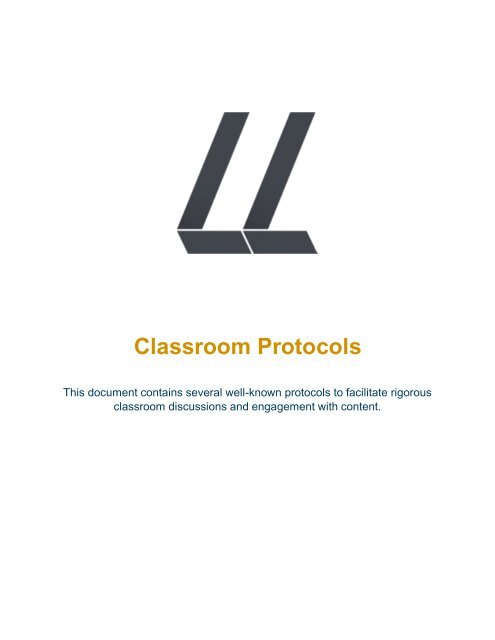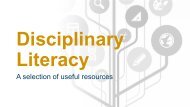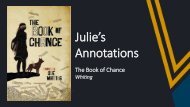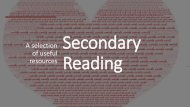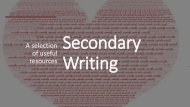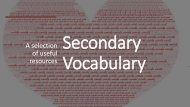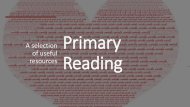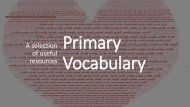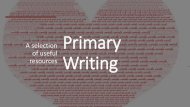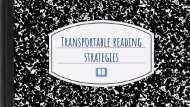Protocols for Classroom Talk
Create successful ePaper yourself
Turn your PDF publications into a flip-book with our unique Google optimized e-Paper software.
<strong>Classroom</strong> <strong>Protocols</strong><br />
This document contains several well-known protocols to facilitate rigorous<br />
classroom discussions and engagement with content.
Contents<br />
Admit and Exit Tickets ............................................................................................................... 2<br />
Chalk <strong>Talk</strong> .................................................................................................................................. 3<br />
Close Viewing ............................................................................................................................ 5<br />
Dance Card ................................................................................................................................ 6<br />
Fishbowl ..................................................................................................................................... 7<br />
Jigsaw ........................................................................................................................................ 8<br />
Philosophical Chairs .................................................................................................................. 9<br />
Provocative Prompts ................................................................................................................ 10<br />
Save the Last Word <strong>for</strong> ME ...................................................................................................... 11<br />
Socratic Seminar ...................................................................................................................... 12<br />
Text Rendering Experience ..................................................................................................... 16<br />
The Constructivist Listening Dyad ........................................................................................... 17<br />
The Final Word......................................................................................................................... 18<br />
The Harvard ‘Project Zero’ Discussion Protocol .......................................................................... 20<br />
Think-Pair-Share ...................................................................................................................... 21<br />
Three Levels of Text Protocol .................................................................................................. 22<br />
Turn and <strong>Talk</strong> ........................................................................................................................... 23<br />
World Café ............................................................................................................................... 24
Admit and Exit Tickets<br />
Purpose<br />
At the end of class, students write on 3x5 cards or slips of paper an important idea they learned, a question they have,<br />
a prediction about what will come next, a self-assessment of their own progress, or a thought about the lesson <strong>for</strong><br />
the day. Alternatively, students turn in such a response at the start of the next day—based on either the learning from<br />
the day be<strong>for</strong>e or the previous night’s homework. These quick writes can be used to assess students’ knowledge, or<br />
to make decisions about next teaching steps or points that need clarifying. This reflection helps students to focus as<br />
they enter the classroom, or solidifies learning be<strong>for</strong>e they leave.<br />
Materials<br />
3x5 cards, sticky notes, or half sheets of paper with teacher-chosen material copied onto them<br />
Writing utensils<br />
Procedure<br />
1. For 3–5 minutes at the end of class (or at the start of the next one), have students jot responses to the reading or<br />
lesson on 3x5 cards, or on a simple assessment you have designed.<br />
2. Keep the response options simple, e.g., “Jot down one thing you learned and one question you have.”<br />
3. Don’t let the cards become a grading burden. Glance over them <strong>for</strong> a quick assessment and to help you with planning<br />
<strong>for</strong> next learning needs. These are simple, quick writes, not final drafts.<br />
4. After studying the “deck,” you might pick out a few typical/unique/thought-provoking cards to spark discussion.<br />
5. Cards could be typed up, anonymously if desired, to share with the whole group so they can help with summariz -<br />
ing, synthesizing, or looking <strong>for</strong> important ideas. It is a good idea to let students know ahead of time that this will<br />
be done, as they may put more ef<strong>for</strong>t into the write-up. When typing, edit <strong>for</strong> spelling and grammar.<br />
Variations<br />
3-2-1: Have students write three of something, two of something, then one of something. For example, students<br />
might explain three things they learned, two areas in which they are confused, and one thing about which they’d like<br />
to know more or one way the topic can be applied. The criteria <strong>for</strong> listing items are up to the needs of the<br />
teacher and the lesson, but it’s important to make the category <strong>for</strong> listing three items easier than the category <strong>for</strong><br />
listing one.<br />
| Language Arts Curriculum 4
Chalk <strong>Talk</strong><br />
Purpose<br />
A Chalk <strong>Talk</strong> is a written protocol in which students respond in writing, in a central place (such as a piece of chart<br />
paper), to an important, open-ended question—silently. It is a way to promote discussion and awareness of issues,<br />
perspectives, or academic challenges. Chalk <strong>Talk</strong>s bypass the social roadblocks that often impede classroom commu -<br />
nication, and ensure that all voices are heard. A Chalk <strong>Talk</strong> is also an excellent way to promote awareness of patterns<br />
and problems, as students reflect on the in<strong>for</strong>mation they have shared.<br />
Materials<br />
Chart paper<br />
Markers (to write questions in bold letters on chart paper)<br />
Colored writing utensils, one per student<br />
Optional: sticky notes<br />
Anchor chart <strong>for</strong> protocol norms<br />
Procedure<br />
1. Formulate one or more important, open-ended questions that will provoke comments and responses.<br />
2. Write the questions or topics on separate pieces of chart paper in bold marker. Post the charts on the wall or on<br />
desks so that all students have ready access to them.<br />
3. Give each student a different-colored pencil or marker.<br />
4. Explain the Chalk <strong>Talk</strong> protocol and answer any student questions.<br />
5. Set up norms <strong>for</strong> the Chalk <strong>Talk</strong>.<br />
6. This technique works only if everyone is writing and responding throughout the designated time period and remains<br />
silent throughout.<br />
7. Make it clear that everyone is responsible <strong>for</strong> writing a comment, reading others’ comments, and responding to at<br />
least one to three comments on every chart paper.<br />
8. No one should sit down until the time period is over.<br />
9. Opinions must be freely expressed and honored. No personal attacks are allowed.<br />
10. Comments should be thoughtful and further the discussion.<br />
11. Allow 10 to 20 minutes <strong>for</strong> the Chalk <strong>Talk</strong>. It’s helpful to walk around, read, and gently point students to interest -<br />
ing comments. All writing and responding is done in silence.<br />
12. Search <strong>for</strong> patterns. In pairs, students should read through all the postings, search <strong>for</strong> patterns and themes (or<br />
“notice and wonder”), and record those patterns on a piece of paper. This part takes about 5 minutes and is not<br />
silent.<br />
13. Conduct a whole-group share. Pairs should report out patterns and themes, round-robin style, until all perceptions<br />
are shared.<br />
Variations<br />
Have students write on and post sticky notes instead of responding directly on the chart paper, so chart paper can<br />
be reused <strong>for</strong> multiple classes if needed.<br />
| Language Arts Curriculum 11
Adding an element of optional text coding (e.g., students placing a star next to comments they agree with or a<br />
question mark on comments they don’t understand) can deepen the written discussion.<br />
Technological versions of Chalk <strong>Talk</strong> (such as commenting on a teacher-owned blog) may further students’ interest<br />
and engagement. However, bear in mind that switching the <strong>for</strong>mat of Chalk <strong>Talk</strong> to a technological <strong>for</strong>um will<br />
require different guidelines, routines, and piloting to proactively plan <strong>for</strong> possible challenges.<br />
References<br />
Adapated from: Original © by Hilton Smith, Foxfire Fund; adapted by Marylyn Wentworth<br />
| Language Arts Curriculum 12
Close Viewing<br />
Purpose<br />
This protocol helps students focus on the details in a picture, photograph, or illustration in an ef<strong>for</strong>t to add to their<br />
growing understanding on a given text or topic. It is designed to provide time <strong>for</strong> students to talk through their ideas<br />
with a partner be<strong>for</strong>e writing or drawing about them independently.<br />
Materials<br />
Picture, photograph, or illustration<br />
Procedure<br />
1. Direct students to zoom in on one part of the image.<br />
2. Have students look closely at the details in that part of the image.<br />
3. Invite students to think about what they can learn or infer from these details.<br />
4. Have students turn to an elbow partner and talk about the details they noticed and what they have learned or<br />
inferred from these details.<br />
5. Invite students to draw and/or write a note about the details they noticed.<br />
6. Repeat steps 1–5 with additional images.<br />
Variations<br />
To focus pair interaction or to stimulate a specific type of thinking, consider providing a sentence stem <strong>for</strong> step 4.<br />
Use this protocol as a kickoff to a module in order to spark student interest.<br />
This protocol can also be used with artifacts/realia.<br />
| Language Arts Curriculum 13
Dance Card<br />
Purpose<br />
Dance Card sets up students with multiple, but consistent, partners <strong>for</strong> work across a unit, reducing the amount of<br />
energy and work it takes <strong>for</strong> the teacher to assign partners. It allows students autonomy and choice in whom they<br />
pick <strong>for</strong> partner work. Students of all ages are familiar with the idea of partnering off <strong>for</strong> dancing, although teachers<br />
may wish to explain the metaphor of the historical “dance card.”<br />
Materials<br />
Three index cards per student, each in a different color, easily distinguishable from the others<br />
Recording <strong>for</strong>m <strong>for</strong> Dance Card names (to be kept throughout the module; one per student)<br />
Procedure<br />
1. Give the three colored index cards to each student. Students write their name on each card.<br />
2. At your signal to “dance,” students find one partner to trade their blue card with. This pair becomes blue “dance<br />
card” partners. Then direct students to do the same with their red card, green card, etc. (or whatever colors are<br />
being used). Optionally, <strong>for</strong> fun or to fill a need <strong>for</strong> movement, students can “dance” over to do their trade, do a<br />
quick dance after the trade (e.g., the chicken dance), or you can play music during this transition. Remind students<br />
that they can only pair up together <strong>for</strong> one of their colors. They must end up with as many different partners<br />
as they have colored index cards.<br />
3. Once all rounds are complete, students fill in the recording sheet with the names of their three different partners.<br />
4. At the end of the protocol, each student has different partners <strong>for</strong> discussion to be used repeatedly, but with variety,<br />
throughout the unit. When it is time <strong>for</strong> students to pair up, you can direct them to their “blue dance partner,”<br />
“red dance partner,” and so on.<br />
Variations<br />
This protocol can involve any number of partners. Colors are used <strong>for</strong> ease of repeating the protocol, but you may<br />
choose to add names to the dance cards (e.g., “Sudanese desert”; “the refugee camp”; “the box car”) pertinent to<br />
the unit of study. If you wish to pre-assign a partnership <strong>for</strong> any reason, fill out two cards of matching color with<br />
the names you want matched and give them to the appropriate students be<strong>for</strong>e the dancing begins.<br />
| Language Arts Curriculum 15
Fishbowl<br />
Purpose<br />
The fishbowl is a peer-learning strategy in which some students are in an outer circle and one or more are in the<br />
center. In all fishbowl activities, both those in the inner and those in the outer circles have roles to fulfill. Students in<br />
the center model a particular practice or strategy. The outer circle acts as observers and may assess the interaction<br />
of the center group. Fishbowls can be used to assess comprehension, to assess group work, to encourage constructive<br />
peer assessment, to discuss issues in the classroom, or to model specific techniques such as literature circles or<br />
Socratic Seminars.<br />
Materials<br />
Chairs or desks <strong>for</strong> each student arranged in two concentric circles<br />
Checklist or reflection questions <strong>for</strong> the outer circle students, depending on the instructional need<br />
Procedure<br />
1. Arrange chairs in the classroom in two concentric circles. The inner circle may be only a small group or even<br />
partners.<br />
2. Explain the activity to the students and ensure that they understand the roles they will play.<br />
3. You may either in<strong>for</strong>m those that will be on the inside ahead of time, so they can be prepared or just tell them as the<br />
activity begins. This way everyone will come better prepared.<br />
4. The group in the inner circle interacts using a discussion protocol or the “script” of a role play.<br />
5. Give each student in the outer circle a list of aspects of group interaction they should silently observe and comment<br />
on—<strong>for</strong> example, whether the group members use names to address each other, take turns, or let everyone’s<br />
voice be heard.<br />
6. Make sure all students have turns being in both the inside and the outside circle at some point, though they don’t all<br />
have to be in both every time you do a Fishbowl activity.<br />
Variations<br />
Each person in the outside circle can have one opportunity during the fishbowl to freeze or stop the inside students.<br />
This person can then ask a question or share an insight.<br />
Have each student in the outer circle observe one student in the inner circle (you may have to double, triple, or<br />
quadruple up)— <strong>for</strong> example, tallying how many times the student participates or asks a question.<br />
| Language Arts Curriculum 17
Jigsaw Description<br />
Adapted from the work of Spencer Kagan, Resources <strong>for</strong> Teachers, San Juan Capistrano, CA.<br />
The purpose of Jigsaw is shared learning. Members of a group become “experts” in a particular area of a<br />
mutual pursuit and share their learning/ research with the other group members. It is also used when a lot<br />
of learning needs to happen in a short time. Chapters of books can be split up, various approaches to the<br />
same outcome can be researched, different experiments with the same materials can be conducted, different<br />
viewpoints on the same issue can be studied, and the results shared. This is effective <strong>for</strong> students or adults.<br />
There are several ways this can happen:<br />
Within Team Jigsaw<br />
Each member of a team/group works independently to master a portion of a topic or skill. When each<br />
team member has completed the work as planned, they gather at an agreed upon time to share the new<br />
knowledge. Often there is some kind of synthesis of the shared knowledge. Example: There are four protocols<br />
<strong>for</strong> observing in a classroom. Each person in a group of four reads one of the observation protocols and<br />
presents that approach to the other team members, with guiding questions to assist the shared learning, such<br />
as “What kind of feedback is generated by this protocol?” “What kind of observation is most appropriate <strong>for</strong><br />
this protocol?” “What is the value of this protocol in terms of student learning; teacher practice?” The group<br />
compares and contrasts the four protocols.<br />
Team Jigsaw<br />
Each team becomes an “expert” on one topic or skill. Team members spread out to share their new<br />
knowledge with the rest of the teams. Team #1 spreads out and sends a member to each of the other teams<br />
to share, then Team #2 does the same. There’s a bit of math to do here as there have to be enough “experts”<br />
to share with all the other teams, or teams have to be combined to share “experts.” Two teams can research<br />
the same topic and check with one another <strong>for</strong> completeness and agreement be<strong>for</strong>e they “consult” with the<br />
other teams - this provides some checks and balances. Synthesis can be done as a whole group or in teams.<br />
Example: There are four protocols <strong>for</strong> observing in a classroom. The room is divided into 4 teams of 3 people,<br />
(or 6 people). Each team studies one protocol, talking together and planning the best way to present the<br />
protocol to the other teams, using the guiding questions. Each team takes turns sending its “experts” out to<br />
the other teams (alone or as a pair) to share the protocol they have studied. A whole group synthesis that<br />
compares the four approaches.<br />
Expert Group Jigsaw<br />
Each member of a team takes on a portion/aspect of a topic or skill. More than one member of the team will<br />
take on the same portion/aspect if there are more group members than portions/ aspects. The team splits<br />
up and everyone goes to an “expert” group of all the people from all the teams taking on the same portion/<br />
aspect. The “expert” group masters the topic/skill or does the research necessary. The “expert” group plans a<br />
way to present their learning in the best possible way and practices the presentation if necessary. The “experts”<br />
all return to their teams where they make presentations to their team members. Synthesis is done in the teams.<br />
Example: There are four protocols <strong>for</strong> observing in a classroom. Each team assigns its members one of the four<br />
protocols. The team members break up and go with the appropriate “expert” group to study the protocol,<br />
discuss it together <strong>for</strong> understanding, using the guiding questions. They plan a presentation. The “experts”<br />
return to their team and each protocol is presented in turn. The protocols are compared in the teams.<br />
<strong>Protocols</strong> are most powerful and effective when used within an ongoing professional learning community and facilitated by a skilled facilitator. To learn more<br />
about professional learning communities and seminars <strong>for</strong> facilitation, please visit the School Re<strong>for</strong>m Initiative website at www.schoolre<strong>for</strong>minitiative.org
Philosophical Chairs<br />
“The role of a teacher is to design and guide students through engaging learning opportunities.”<br />
What do you think? Do you agree or disagree?<br />
At our Instructional Leadership Team meeting last week, we had the chance to voice our<br />
opinions on the statement above. We examined the role of a teacher through a “Philosophical<br />
Chairs” discussion led by my colleague Tony Borash. Philosophical Chairs is a strategy <strong>for</strong><br />
exploring a controversial topic through discussion. Using the protocol to guide our discussion<br />
gave us the opportunity to defend and think deeply about our ideas. As you can imagine, some<br />
of us switched sides several times!<br />
The protocol is not only useful during professional development with teachers, it would be an<br />
interesting one to use when preparing your students to write persuasively. Through<br />
Philosophical Chairs, they have the opportunity to listen and understand an opposing side as<br />
well as clarify and state their personal beliefs succinctly. Using the discussion, they would then<br />
have a tremendous amount of in<strong>for</strong>mation to think about when they write.<br />
The protocol works as follows:<br />
1. Choose and post a controversial statement that participants can either agree or disagree<br />
with.<br />
2. Set up two rows of chairs facing one another. One side <strong>for</strong> participants who agree with<br />
the statement; the other side <strong>for</strong> folks who disagree.<br />
3. Have participants move to one row or the other, depending on their belief or opinion.<br />
4. Participants then take turns defending their position and may switch sides at any time.<br />
5. Three rules guide the discussion: one person speaks at a time, everyone must have a<br />
turn be<strong>for</strong>e someone speaks twice, and you must repeat what the person on the<br />
opposing side said be<strong>for</strong>e you share your opinion.<br />
6. The teacher serves as the moderator, helping speakers to stay on topic, encouraging all<br />
students to speak, and asking additional probing questions to keep the discussion going.
Provocative Prompts <strong>for</strong> Equity<br />
Developed in the field by educators.<br />
Essential Question: What does it really mean to do “equity work”?<br />
“There are many ways to do diversity work. The most exciting, the most effective entry point as I see it, is<br />
helping people learn how to talk and listen to one another. Everyone has a story to tell about the impact of<br />
differences on their lives and careers. Most people want to tell their story. The heart and soul of this work<br />
is giving people the chance to talk.”<br />
Barbara Walker, Teaching Diversity, Gallos, et al, Jossey-Bass, San Francisco, 1997.<br />
“…groups can often avoid unproductive situations if members recognize that inequity and prejudice<br />
have grown out of societal oppression or distressing earlier experiences. People need opportunities to<br />
work through the feelings from these hurts. Participants also need to be reminded that emotional release<br />
(through tears, trembling, laughing and talking, <strong>for</strong> example) is the natural healing process from the<br />
distress they have experienced. It is also important <strong>for</strong> people to be able to talk about the first time they<br />
encountered prejudice and inequity and their feelings at the time.”<br />
Julian Weissglasss, “Deepening our Dialogue About Equity,” Educational Leadership, ASCD, April 1997.<br />
“We agree with Mr. Weissglass’s concise diagnosis, but he does not go deeply enough into the structures<br />
and policies that allow racism to be active in the lives of children and the business of our schools.<br />
We have to change the facts, not just the feelings that nurture and are nurtured by deep and historic<br />
social engineering that divides races and economic classes in America. It will take honest dialogue and<br />
leadership, but also much more than that to put our society and our students on equitable footing.”<br />
National Urban Alliance <strong>for</strong> Effective Education, National Advisors: Alan E. Farstrup, Peter Gerber, Asa<br />
Hilliard, III, Lisa Delpit.<br />
“I worry that in this country, we’ll only learn to value differences one at a time — work on each separately,<br />
difference by difference by difference. We view life in terms of its dualism: good (my way) or bad (your<br />
way). Instead, I wish we could learn, truly learn, that the fundamental problem is our basic attitude toward<br />
difference.”<br />
Barbara Walker, Teaching Diversity, Gallos et al, Jossey-Bass, San Francisco, 1997<br />
“Even in schools with very small populations of color, educators are becoming more aware of the need to<br />
prepare white students to live in a multiracial society. Yet this is a world with which the current teaching<br />
<strong>for</strong>ce has limited experience. Most white teachers were raised and educated in predominantly white<br />
communities. Their firsthand knowledge of communities of color and their cultures and histories are quite<br />
limited.”<br />
Sandra M. Larence and Beverly Daniel Tatum, “White Educators as Allies: Moving from Awareness to<br />
Action”, from Off-White, edited by Fine et al<br />
<strong>Protocols</strong> are most powerful and effective when used within an ongoing professional learning community and facilitated by a skilled facilitator. To learn more<br />
about professional learning communities and seminars <strong>for</strong> facilitation, please visit the School Re<strong>for</strong>m Initiative website at www.schoolre<strong>for</strong>minitiative.org
“Because of the prejudice and racism inherent in our environments when we were children, I assume that<br />
we cannot be blamed <strong>for</strong> learning what we were taught (intentionally or unintentionally). Yet as adults, we<br />
have a responsibility to try to identify and interrupt the cycle of oppression. When we recognize that we<br />
have been misin<strong>for</strong>med, we have a responsibility to seek out more accurate in<strong>for</strong>mation and to adjust our<br />
behavior accordingly.”<br />
Beverly Daniel Tatum, ”<strong>Talk</strong>ing about Race, Learning about Racism: the Application of Racial Identity<br />
Development Theory in the <strong>Classroom</strong>,” Harvard Educational Review, Spring, 1992.<br />
“For White students, the internalization of a newly defined sense of oneself as White is the primary task of<br />
the Autonomy stage. The positive feelings associated with this redefinition energize the person’s ef<strong>for</strong>ts to<br />
confront racism and oppression in his or her daily life. Alliances with people of color can be more easily<br />
<strong>for</strong>ged at this stage of development than previously because the person’s antiracist behaviors and attitudes<br />
will be more consistently expressed.”<br />
Beverly Daniel Tatum, “<strong>Talk</strong>ing about Race, Learning about Racism: the Application of Racial Identity<br />
Development Theory in the <strong>Classroom</strong>,” Harvard Educational Review, Spring, 1992.<br />
<strong>Protocols</strong> are most powerful and effective when used within an ongoing professional learning community and facilitated by a skilled facilitator. To learn more<br />
about professional learning communities and seminars <strong>for</strong> facilitation, please visit the School Re<strong>for</strong>m Initiative website at www.schoolre<strong>for</strong>minitiative.org
Activities to Use With Provocative Prompts<br />
Essential Question: What does it really mean to do “equity work”?<br />
Using the attached list of quotations from various sources, choose one of the following activities:<br />
1. Each member of the group chooses one quotation and shares why it is his/her choice in a go-round—<br />
five minutes each.<br />
2. Members of the group walk around and find a partner; each person shares with that partner one<br />
quotation which has made them think differently. Variation: After sharing with the first partner, finding a<br />
new partner and now taking on the point of view of the first person talked with. And so on.<br />
3. Members of the group answer the essential question referring to the quotations.<br />
4. The paper is cut into individual strips with one quotation each. Quotations are given out randomly and<br />
each person reads the one she/he gets and responds to it.<br />
5. The quotations are used with a text-based protocol (e.g. The Final Word).<br />
<strong>Protocols</strong> are most powerful and effective when used within an ongoing professional learning community and facilitated by a skilled facilitator. To learn more<br />
about professional learning communities and seminars <strong>for</strong> facilitation, please visit the School Re<strong>for</strong>m Initiative website at www.schoolre<strong>for</strong>minitiative.org
National<br />
School<br />
Re<strong>for</strong>m<br />
Faculty<br />
Harmony<br />
Education<br />
Center<br />
www.nsrfharmony.org<br />
Save the Last Word <strong>for</strong> ME<br />
Developed by Patricia Averette.<br />
Purpose<br />
To clarify and deepen our thinking about articles we read.<br />
Roles<br />
Timekeeper/facilitator, who both participates and keeps the process moving.<br />
The process is designed to build on each other’s thinking, and not to enter into a dialogue.<br />
Participants may decide to have an open dialogue about the text at the end of the 30 minutes.<br />
Timing is important; each round should last approximately 7 minutes.<br />
Total Time<br />
approximately 30 minutes.<br />
The Protocol<br />
1. Create a group of 4 participants. Choose a timekeeper (who also participates) who has a watch.<br />
2. Each participant silently identifies what s/he considers to be (<strong>for</strong> him or her) the most significant idea<br />
addressed in the article, and highlights that passage.<br />
3. When the group is ready, a volunteer member identifies the part of the article that s/he found to be most<br />
significant and reads it out loud to the group. This person (the presenter) says nothing about why s/he<br />
chose that particular passage.<br />
4. The group should pause <strong>for</strong> a moment to consider the passage be<strong>for</strong>e moving to the next step.<br />
5. The other 3 participants each have 1 minute to respond to the passage — saying what it makes them<br />
think about, what questions it raises <strong>for</strong> them, etc.<br />
6. The first participant then has 3 minutes to state why s/he chose that part of the article and to respond to<br />
— or build on — what s/he heard from his/her colleagues.<br />
7. The same pattern is followed until all four members of the group have had a chance to be the presenter<br />
and to have “the last word.”<br />
8. Optional open dialogue about the text and the ideas and questions raised during the first part of the<br />
protocol.<br />
9. Debrief the experience. How was this a useful way to explore the ideas in the text and to explore your<br />
own thinking?<br />
<strong>Protocols</strong> are most powerful and effective when used within an ongoing professional learning community such as a Critical Friends Group ® and facilitated<br />
by a skilled coach. To learn more about professional learning communities and seminars <strong>for</strong> new or experienced coaches, please visit the National School<br />
Re<strong>for</strong>m Faculty website at www.nsrfharmony.org.
Socratic Seminar<br />
A Socratic Seminar is a method to try to understand in<strong>for</strong>mation by creating a disciplined classroom<br />
conversation in regards to a specific text. In a Socratic Seminar, participants seek deeper<br />
understanding complex ideas in the text through rigorously thoughtful dialogue. This process<br />
encourages divergent thinking rather than convergent.<br />
> Choosing a text: Socratic Seminars work best with authentic texts that invite authentic<br />
inquiry – an ambiguous and appealing short story, a pair of contrasting primary documents<br />
in social studies, or an article on a controversial approach to an ongoing scientific problem.<br />
> Preparing the students: While students should read carefully and prepare well <strong>for</strong> every<br />
class session, it is usually best to tell students ahead of time when they will be expected to<br />
participate in a Socratic seminar. Because seminars ask students to keep focusing back on<br />
the text, you may distribute sticky notes <strong>for</strong> students to use to annotate the text as they read.<br />
> Prepare the question: Though students may eventually be given responsibility <strong>for</strong> running<br />
the entire session, the teacher usually fills the role of discussion leader as students learn<br />
about seminars and questioning. Generate as many open-ended questions as possible,<br />
aiming <strong>for</strong> questions that relate more directly to students’ lives, so the entire conversation is<br />
rooted in the context of their real experiences.<br />
> Establishing your role: Though you may assume leadership through determining which<br />
open-ended questions students will explore (at first), the teacher should not see him or<br />
herself as a significant participant in the pursuit of those questions. You may find it useful to<br />
limit your intrusions to helpful reminders about procedures (e.g. “Maybe this is a good time to<br />
turn our attention back the text?” “Do we feel ready to explore a different aspect of the<br />
text?”). Resist the urge to correct or redirect, relying instead on other students to respectfully<br />
challenge their peers’ interpretation or offer alternative views.<br />
> Assessing effectiveness: Socratic seminars require assessment that respects the central<br />
nature of student-centred inquiry to their success. The most global measure of success is<br />
reflection, both on the part of the teacher and students, on the degree to which text-centred<br />
student talk dominated the time and work of the session. Reflective writing asking students<br />
to describe their participation and set their own goals <strong>for</strong> future seminars can be effective as<br />
well. Understand that, like the seminars themselves, the process of gaining capacity <strong>for</strong><br />
inquiry into text is more important than “getting it right” at any particular point.
Setting it up:<br />
<strong>Classroom</strong> Environment<br />
The classroom should be arranged so that students can look at each other directly. A circle or<br />
square works well. Some teachers like to use desks and have students use name card tents;<br />
others prefer simply to use chairs without desks. The discussion norms should be prominently<br />
posted. Some teachers like to also post the initial key question.<br />
Questions<br />
Prepare several questions in advance, in addition to questions that students may bring to class.<br />
Questions should lead participants into the core ideas and values and o the use of the text in<br />
their answers. Questions must be open-ended, reflect genuine curiosity, and have no ‘one right<br />
answer’! Choose one question as the key interpretive question of the seminar to focus on and<br />
begin discussion.<br />
During the seminar, use particular questions to move the discussion along. Towards the end of<br />
the seminar, some teachers like to use closing questions that encourage participants to apply<br />
the ideas to their personal experiences and opinions. Answering these closing questions does<br />
not require uses of the text but provides students with the chance to share their own<br />
perspectives. Lastly, debriefing questions help students reflect on the process of the seminar.<br />
> Sample questions to serve as the key question or interpret the text:<br />
What is the main idea or underlying value in the text?<br />
What is the author’s purpose or perspective?<br />
What does (a particular phrase) mean?<br />
What might be a good title <strong>for</strong> the text?<br />
What is the most important word/ sentence/ paragraph?<br />
> Sample questions to move the discussion along:<br />
Who has a different perspective?<br />
Who has not yet had a chance to speak?<br />
Where do you find evidence <strong>for</strong> that in the text?<br />
Can you clarify what you mean by that?<br />
How does that relate to what (someone else) said?<br />
Is there something in the text that is unclear to you?<br />
Has anyone changed their mind?<br />
> Sample questions to bring the discussion back to the students in closing:<br />
How do the ideas in the text relate to our lives? What do they mean <strong>for</strong> us personally?
Why is this material important?<br />
Is it right that…? Do you agree with author?<br />
> Sample debriefing questions:<br />
Do you feel like you understand the text at a deeper level?<br />
How was the process <strong>for</strong> us? Did we adhere to our norms?<br />
Did you achieve your goals to participant?<br />
What was one thing you noticed about the seminar?<br />
Socratic Structure<br />
The Seminar can be divided into three time periods:<br />
Be<strong>for</strong>e the Seminar<br />
> Introduce the seminar and its purpose (to facilitate a deeper understanding of the ideas<br />
and values in the text through shared discussion.<br />
> Have students read the text. They may use one of several <strong>for</strong>mats to process the<br />
in<strong>for</strong>mation.<br />
o<br />
The Open-Ended Questions and/ or the Critical Reasoning Analysis Sheet can<br />
be used to help students understand the content. These can be used as the<br />
‘ticket’ to participate in the seminar. Share any expectations related to<br />
assessment.<br />
> Review the Discussion Norms<br />
> In addition to the classroom discussion norms you may have already set, it is important<br />
to include the following norms, or ones that are similar:<br />
o<br />
o<br />
o<br />
o<br />
Don’t raise hands<br />
Listen carefully<br />
Address one another respectfully<br />
Base any opinions on the text<br />
Additional norms might include:<br />
o<br />
o<br />
o<br />
o<br />
Address comments to the group (no side conversations)<br />
Use sensitivities to take turns and not interrupt others<br />
Monitor ‘air time’<br />
Be courageous in presenting your own thoughts and reasoning but be flexible<br />
and willing to change your mind in the face of new and compelling evidence.
During the Seminar<br />
> Be seated at the level of the students and remind them to address each other and not<br />
you?<br />
> Pos the key question.<br />
> Ask participants to relate their statements to particular passage, to clarify, and to<br />
elaborate.<br />
> If the conversation gets off track, refocus students on the opening question by restating<br />
it.<br />
> Use additional questions to move the discussion along.<br />
> Invite those who have not spoken into the conversation. Some teachers use talking chips<br />
(each student is allotted a number of chips that they use when they make a contribution)<br />
or a talking chain (asking each person to comment or pass in a circle). The chips may be<br />
especially useful when working with very young children but should be used only until<br />
students ‘get the idea’.<br />
> You may wish to record <strong>for</strong> your own purposes the main ideas discussed, and the<br />
contributions people make (using a shorthand or diagram) to refer to as you facilitate.<br />
> If can be helpful to summarise the main points made in the discussion, either at a quiet<br />
point or towards the end of the discussion.<br />
After the Seminar<br />
> Ask debriefing questions of the students.<br />
> Share your own experience with the seminar as a facilitator.<br />
*Variation: Fishbowl*<br />
If you have a large class, it may be helpful to divide the students into two groups and use a<br />
fishbowl <strong>for</strong>mat.<br />
One half of the class is in the ‘centre’ facing each other and discussing the text, while the<br />
remainder is on the ‘outside’ observing and listening. Members of the outer circle can take notes<br />
or use an evaluation <strong>for</strong>m to track the overall conversation or to focus on specific participants.<br />
The Rubric <strong>for</strong> Evaluating <strong>Classroom</strong> Discussions, as well as the Socratic Seminar Fishbowl<br />
Discussion Partner Evaluation could be used <strong>for</strong> this purpose.<br />
During the seminar, some teachers reserve an empty ‘hotseat’ <strong>for</strong> those in the outer circle who<br />
really want to jump in to make a contribution and then leave.<br />
At the end of the conversation, the outer circle can share their observations. The groups then<br />
switch to allow the outer group a change to discuss.
Harmony<br />
Education<br />
Center<br />
Purpose<br />
National<br />
School<br />
Re<strong>for</strong>m<br />
Faculty<br />
www.nsrfharmony.org<br />
Text Rendering Experience<br />
Developed in the field by educators affiliated with NSRF.<br />
To collaboratively construct meaning, clarify, and expand our thinking about a text or document.<br />
Roles<br />
A facilitator to guide the process.<br />
A scribe to track the phrases and words that are shared.<br />
Set Up<br />
Take a few moments to review the document and mark the sentence, the phrase, and the word that you<br />
think is particularly important <strong>for</strong> our work.<br />
Steps<br />
1. First Round: Each person shares a sentence from the document that he/she thinks/feels is particularly<br />
significant.<br />
2. Second Round: Each person shares a phrase that he/she thinks/feels is particularly significant. The scribe<br />
records each phrase.<br />
3. Third Round: Each person shares the word that he/she thinks/feels is particularly significant. The scribe<br />
records each word.<br />
4. The group discusses what they heard and what it says about the document.<br />
5. The group shares the words that emerged and any new insights about the document.<br />
6. The group debriefs the text rendering process.<br />
<strong>Protocols</strong> are most powerful and effective when used within an ongoing professional learning community such as a Critical Friends Group ® and facilitated<br />
by a skilled coach. To learn more about professional learning communities and seminars <strong>for</strong> new or experienced coaches, please visit the National School<br />
Re<strong>for</strong>m Faculty website at www.nsrfharmony.org.
National<br />
School<br />
Re<strong>for</strong>m<br />
Faculty<br />
Harmony<br />
Education<br />
Center<br />
www.nsrfharmony.org<br />
The Constructivist Listening Dyad<br />
Adapted from the National Coalition <strong>for</strong> Equity in Education by Victor Cary<br />
Purpose<br />
To create a safe space to become better at listening and talking in depth. Constructivist listening dyads<br />
help us as we work through feelings, thoughts, and beliefs that sometimes produce anger, passivity,<br />
undermine confidence, or cause interference in relationships with students or colleagues.<br />
Time allotted: 2 to 30 minutes<br />
Group <strong>for</strong>mat: Pairs.<br />
Supplies: A timer<br />
Facilitation tips: <strong>Talk</strong> about the purpose of a constructivist listening dyad.<br />
The simplest <strong>for</strong>m of doing constructivist listening is a dyad, which is the exchange of constructivist<br />
listening between two people….<br />
I agree to listen to and think about you <strong>for</strong> a fixed period of time in exchange <strong>for</strong> you doing the same <strong>for</strong><br />
me. I keep in my mind that my listening is <strong>for</strong> your benefit so I do not ask questions <strong>for</strong> my in<strong>for</strong>mation.<br />
Start with two minutes — at first it may seem difficult. But participants, over the course of time, may work<br />
their way up to 5-8 minutes and more each. Remind participants that the purpose of a constructivist<br />
listening dyad is that the listening is <strong>for</strong> the benefit of the talker. This is an essential point to access the<br />
usefulness and power of a constructivist listening dyad.<br />
Guidelines <strong>for</strong> Constructivist Listening:<br />
1) Each person is given equal time to talk. (Everyone deserves to be listened to.)<br />
2) The listener does not interpret, paraphrase, analyze, give advice or break in with a personal story.<br />
(People can solve their own problems.)<br />
3) Confidentiality is maintained. (People need to know they can be completely authentic.)<br />
4) The talker does not criticize or complain about a listener(s) or about mutual colleagues during their<br />
time to talk. (A person cannot listen well when she/he is feeling attacked or defensive.)<br />
The Activity:<br />
1. Each person will have two minutes or more to respond to a prompt. It is very useful to scaffold the prompts.<br />
Ex: When is the last time you remembered being fully listened too? How did it feel?<br />
Growing up, what was your experience as a learner? What felt supportive? What interfered with your learning?<br />
How did race, class or gender impact your experience as a learner in school?<br />
Reflection questions following the activity:<br />
• What came up <strong>for</strong> you using this structure? What came up <strong>for</strong> you reflecting on the prompt?<br />
• What worked <strong>for</strong> you? What was difficult <strong>for</strong> you?<br />
• What purpose do you think it might serve?<br />
• When could it be used?<br />
<strong>Protocols</strong> are most powerful and effective when used within an ongoing professional learning community such as a Critical Friends Group ® and facilitated<br />
by a skilled coach. To learn more about professional learning communities and seminars <strong>for</strong> new or experienced coaches, please visit the National School<br />
Re<strong>for</strong>m Faculty website at www.nsrfharmony.org.
Harmony<br />
Education<br />
Center<br />
National<br />
School<br />
Re<strong>for</strong>m<br />
Faculty<br />
www.nsrfharmony.org<br />
The Final Word<br />
Adapted from the original by Jennifer Fischer-Mueller and Gene Thompson-Grove <strong>for</strong> the NSRF.<br />
Purpose<br />
The purpose of this discussion <strong>for</strong>mat is to give each person in the group an opportunity to have their<br />
ideas, understandings, and perspective enhanced by hearing from others. With this <strong>for</strong>mat, the group can<br />
explore an article, clarify their thinking, and have their assumptions and beliefs questioned in order to gain<br />
a deeper understanding of the issue.<br />
Roles<br />
Facilitator / timekeeper (who also participates); participants<br />
Facilitation<br />
Have participants identify one “most” significant idea from the text (underlined or highlighted ahead<br />
of time), stick to the time limits, avoid dialogue, have equal sized circles so all small groups finish at<br />
approximately the same time.<br />
Process<br />
1. Sit in a circle, and identify a facilitator/time-keeper.<br />
2. Each person needs to have one “most” significant idea from the text underlined or highlighted in the<br />
article. It is often helpful to identify a “back up” quote as well.<br />
3. The first person begins by reading what “struck him or her the most” from the article. Have this person<br />
refer to where the quote is in the text - one thought or quote only. Then, in less than 3 minutes, this<br />
person describes why that quote struck him or her. For example, why does s/he agree/disagree with the<br />
quote, what questions does s/he have about that quote, what issues does it raise <strong>for</strong> him or her, what<br />
does s/he now wonder about in relation to that quote?<br />
4. Continuing around the circle each person responds to that quote and what the presenter said, briefly, in<br />
less than a minute. The purpose of the response is:<br />
• to expand on the presenter’s thinking about the quote and the issues raised <strong>for</strong> him or her by the quote,<br />
• to provide a different look at the quote,<br />
• to clarify the presenter’s thinking about the quote, and/or<br />
• to question the presenter’s assumptions about the quote and the issues raised (although at this time<br />
there is no response from the presenter).<br />
5. After going around the circle with each person having responded <strong>for</strong> less than one minute, the person<br />
that began has the “final word.” In no more than one minute the presenter responds to what has been<br />
said. Now what is s/he thinking? What is his or her reaction to what s/he has heard?<br />
<strong>Protocols</strong> are most powerful and effective when used within an ongoing professional learning community such as a Critical Friends Group ® and facilitated<br />
by a skilled coach. To learn more about professional learning communities and seminars <strong>for</strong> new or experienced coaches, please visit the National School<br />
Re<strong>for</strong>m Faculty website at www.nsrfharmony.org.
6. The next person in the circle then begins by sharing what struck him or her most from the text. Proceed<br />
around the circle, responding to this next presenter’s quote in the same way as the first presenter’s. This<br />
process continues until each person has had a round with his or her quote.<br />
7. For each round, allow about 8 minutes (circles of 5 participants: presenter 3 minutes, response 1<br />
minute <strong>for</strong> 4 people, final word <strong>for</strong> presenter 1 minute). The role of the facilitator is to keep the process<br />
moving, keep it clear and directed to the article, and keep time so everyone gets an opportunity <strong>for</strong> a<br />
round. Total time is about a <strong>for</strong>ty minutes <strong>for</strong> a group of 5 (32 minutes <strong>for</strong> a group of 4, 48 minutes <strong>for</strong> a<br />
group of 6). End by debriefing the process in your small group.<br />
<strong>Protocols</strong> are most powerful and effective when used within an ongoing professional learning community such as a Critical Friends Group ® and facilitated<br />
by a skilled coach. To learn more about professional learning communities and seminars <strong>for</strong> new or experienced coaches, please visit the National School<br />
Re<strong>for</strong>m Faculty website at www.nsrfharmony.org.
The Harvard ‘Project Zero’ discussion protocol<br />
This activity takes about 35 minutes, but times can be easily adapted. It encourages close<br />
reading, listening to others, group work, and the synthesising and ordering of key ideas. It has<br />
the advantage of a ‘no wrong answer’ instruction, so students are encouraged to take risks in a<br />
low-stakes environment. Other advantages are that every student has the opportunity to be<br />
heard, and everyone has a chance to do some of the reading if they have not already done so!<br />
If a student has had difficulty with the content, they have the opportunity to hear what other<br />
students gained from the reading.<br />
STEP ONE:<br />
Silent reading: Take 10 minutes to revisit the reading you prepared <strong>for</strong> today’s class<br />
> Choose a word, phrase and sentence from the reading that had insight <strong>for</strong> you (10<br />
minutes)<br />
STEP TWO:<br />
From groups of four and appoint a scribe<br />
> Group listening: Each person has two minutes to talk about their word, phrase and<br />
sentence and why they chose it. During this time, they ‘have the floor’ – they shouldn’t<br />
be interrupted by the others. (8 minutes)<br />
> Group discussion: After everyone had contributed, the group decides on the three most<br />
important elements that have emerged from the reading <strong>for</strong> them. (4 minutes)<br />
STEP THREE:<br />
Each group of four has two minutes to share its insights with the whole group (10 minutes)
Think-Pair-Share<br />
Purpose<br />
This protocol promotes productive and equitable conversations, where all students are given the time and space to<br />
think, share, and consider the ideas of others. It ensures that all students simultaneously engage with the same text<br />
or topic, while promoting synthesis and the social construction of knowledge.<br />
Materials<br />
Guiding questions, decided be<strong>for</strong>ehand<br />
Optional: recording <strong>for</strong>m with questions and answer spaces <strong>for</strong> students<br />
Procedure<br />
1. Move students into pairs and invite them to label themselves A and B.<br />
2. Pose the question and give students time to think independently and silently about their answer to the question.<br />
3. Invite partner A to ask partner B the question.<br />
4. Give partner B a specified timeframe (e.g., 30 seconds, 1 minute, etc.) to share his or her response.<br />
5. Have partners reverse roles and repeat steps 3–4.<br />
6. Using a total participation technique (e.g., cold call, equity sticks, etc.), invite students to share their responses<br />
with the whole group.<br />
7. Repeat this process with remaining questions.<br />
Variations<br />
Pair the Think-Pair-Share protocol with a close reading lesson to allow students time and space to collaboratively<br />
work on their answers to text-dependent questions.<br />
Expand groupings to include three students (Think-Triad-Share). Ensure all students have time to think, repeat<br />
the question to a group member, and share their thoughts.<br />
References<br />
Lymna, F. (1981). The responsive classroom discussion: The inclusion of all students. In Mainstreaming digest.<br />
College Park, MD: University of Maryland College of Education.<br />
| Language Arts Curriculum 40
Harmony<br />
Education<br />
Center<br />
National<br />
School<br />
Re<strong>for</strong>m<br />
Faculty<br />
www.nsrfharmony.org<br />
Three Levels of Text Protocol<br />
Adapted by the Southern Maine Partnership from Camilla Greene’s Rule of 3 Protocol, 11/20/03.<br />
Purpose<br />
To deepen understanding of a text and explore implications <strong>for</strong> participants’ work.<br />
Facilitation<br />
Stick to the time limits. Each round takes up to 5 minutes per person in a group. Emphasize the need to<br />
watch air time during the brief “group response” segment. Do 1 – 3 rounds. Can be used as a prelude to a<br />
Text-based Discussion or by itself.<br />
Roles<br />
Facilitator/timekeeper (who also participates); participants<br />
Process<br />
1. Sit in a circle and identify a facilitator/timekeeper<br />
2. If participants have not done so ahead of time, have them read the text and identify passages (and a<br />
couple of back-ups) that they feel may have important implications <strong>for</strong> their work.<br />
3. A Round consists of:<br />
• One person using up to 3 minutes to:<br />
LEVEL 1: Read aloud the passage she/he has selected<br />
LEVEL 2: Say what she/he thinks about the passage (interpretation, connection to past experiences, etc.)<br />
LEVEL 3: Say what she/he sees as the implications <strong>for</strong> his/her work.<br />
• The group responding (<strong>for</strong> a TOTAL of up to 2 minutes) to what has been said.<br />
4. After all rounds have been completed, debrief the process.<br />
<strong>Protocols</strong> are most powerful and effective when used within an ongoing professional learning community such as a Critical Friends Group ® and facilitated<br />
by a skilled coach. To learn more about professional learning communities and seminars <strong>for</strong> new or experienced coaches, please visit the National School<br />
Re<strong>for</strong>m Faculty website at www.nsrfharmony.org.
Turn and <strong>Talk</strong><br />
Purpose<br />
Turn and <strong>Talk</strong> is one of the easiest, quickest, and most efficient means of creating collaboration among students. It<br />
can be used practically at any time, anywhere, in a lesson in any content area.<br />
Materials<br />
None<br />
Procedure<br />
1. When prompted, students turn to a shoulder buddy or neighbor.<br />
2. In a set amount of time, students share their ideas about a prompt or question posed by the teacher or other students.<br />
3. Depending on the goals of the lesson and the nature of the Turn and <strong>Talk</strong>, students may share some key ideas from<br />
their paired discussions with the whole class.<br />
Variations<br />
Students can use a written version of Turn and <strong>Talk</strong>, brainstorming their answers on paper very briefly and shar-<br />
ing them aloud, or switching papers.<br />
| Language Arts Curriculum 54
World Café<br />
Purpose<br />
To discuss a topic or various topics, rotating the role of leadership and mixing up a group of people. This protocol is<br />
an extensive exercise in listening and speaking skills.<br />
Materials<br />
Chart/poster paper<br />
Marker <strong>for</strong> the leader/recorder<br />
Procedure<br />
1. Form three groups of 3 or 4 and sit together at a table.<br />
2. Each group selects a “leader.”<br />
3. The leader’s role is to record the major points of the conversation that takes place at the table and to then summarize<br />
the conversation using the recorded notes.<br />
4. The group discusses the topic at hand until time is called. Groups can be discussing the same topic or related<br />
topics.<br />
5. The leader stays put; the rest of the group rotates to the next table.<br />
6. The leader (who didn’t move) presents a summary of the conversation recorded from the <strong>for</strong>mer group to the new<br />
group.<br />
7. Each table selects a new leader.<br />
8. Again, the new leader’s role is to record the major points of the conversation that takes place at the table and to<br />
then summarize the conversation using the recorded notes…a bit later.<br />
9. The group discusses the topic at hand until time is called.<br />
10. Repeat the process, ideally until all students have had a chance to lead.<br />
11. After the final round, the last group of leaders present to the whole group rather than reporting out to a “next<br />
rotation.”<br />
Variations<br />
Mix the Room: For large groups, begin with everyone in a circle. Number off around the circle, from one to five.<br />
The teacher provides a prompt, and at the teacher’s signal, each group of five clusters into a small circle to discuss<br />
a topic <strong>for</strong> a designated amount of time. The teacher then signals <strong>for</strong> the 1’s to advance to the next cluster. Ones<br />
then provide a summary of the last group’s discussion, be<strong>for</strong>e the newly <strong>for</strong>med group discusses a second prompt.<br />
Each time a new prompt is given, the teacher asks a different number to move <strong>for</strong>ward to the next cluster, thus<br />
“mixing the room” <strong>for</strong> each new prompt.<br />
References<br />
Adapted from: www.theworldcafe.com<br />
| Language Arts Curriculum 42


